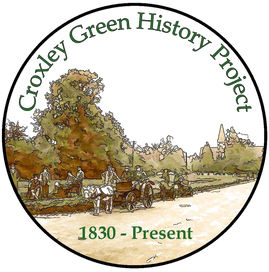Alan Williams
Alan Williams, who is related to the Croxley Green Blacksmith Jesse Gibbs writes,
In the summer of 1966, when I was 17, my parents and I moved to a bungalow at 21 Sherborne Way from my childhood home in Whippendell Road, Watford.
My father had come from South Wales in the 1930s, but my mother’s parents were both from Croxley families. Her mother was Edith Gibbs (born 1890), the youngest daughter of Jesse and Ann Gibbs, Jesse having the blacksmith’s shop in New Road which is nowadays the New Road Service Station. Her father was Walter (Wally) Chapman (born 1888), wheelwright, who worked alongside Jesse Gibbs and his sons in the early-twentieth century.
It might be expected that a village blacksmith’s shop had been in the same family for generation after generation. But in fact the Gibbs were not a long-established Croxley family, and neither were the Chapmans. Both Jesse Gibbs and Walter Chapman hailed (coincidentally?) from the Amersham area of Buckinghamshire. I have been able to trace the Gibbs in Buckinghamshire back to approximately 1640. Earlier generations of the Chapmans – including Walter’s father, John – lived in Bedfordshire, where I have traced them to approximately 1730.
In the past both the Gibbs and the Chapmans had been humble agricultural labourers, and it was only by the late-nineteenth/early-twentieth centuries that they had elevated themselves somewhat by acquiring skilled trades. In 1871 Jesse Gibbs, aged 23, was a lodger in the home of George Rixon in Farnham Royal, Buckinghamshire, a blacksmith, to whom Jesse was presumably apprenticed. By 1881 Jesse appears as a blacksmith in Croxley Green.
The Chapmans followed a similar pattern. In 1881 John Chapman, Walter’s father, was an agricultural labourer in Weston Turville, near Aylesbury. By 1891 he and his family were in Cow Lane, Croxley Green, where he was still recorded as a farm labourer, but by 1901 he had become a carpenter. The 1911 census is more descriptive, stating that he was a carpenter in a “paper mill”, few guesses which one, I’d have thought! Presumably, this influenced Walter to follow broadly the same line of work, specialising in the trade of wheelwright, which is how he is described on the 1911 census.
Walter Chapman was the fourth of eight brothers. In 1911 he was living with his parents and his four younger siblings at 155 New Road, but in 1914 he married my grandmother, Edith Gibbs, and they went to live in Hagden Lane, Watford.
Of the eight Chapman brothers, four volunteered for military service early in the First World War and were celebrated in the ‘Watford Illustrated’ of 11th January 1916. The eldest brother, Albert, was wounded at Hooge in 1915 and had to have his right leg amputated. In 1911 Albert had been living at the stables of the Victoria Hotel in Rickmansworth (which I understand has only recently been demolished) and working as a “horse keeper”, which may explain why he entered a cavalry regiment, the 3rd Dragoon Guards.
Walter Chapman, however, was given an absolute exemption from military service by the Rickmansworth Military Service Tribunal, on account of his occupation, repairing agricultural machinery. I am indebted for this information on the Chapmans to Brian Thomson’s book, ‘Croxley Green in the First World War’.
Walter and Edith Chapman had three girls, the eldest, Joyce, being born in May 1915, and twins, Olive and Dora (my mother) being born on 19th August 1919. Walter, however, died at the age of just 40 in 1928. As I understand it, he had been engaged to repair the wheel of a watermill, which entailed standing for long periods in the mill race, as a consequence of which he caught pneumonia.
This tragedy left Edith to bring up the three girls on very limited income. She had always worked in domestic service. In 1911 she was a live-in servant in the Chorleywood home of a Mr Louis Charles Mieville, who worked on the Stock Exchange. I understand that, at some time, she was employed by the Tussauds, this presumably being the family of John Theodore Tussaud in New Road. Later in life she worked for a Dr Berry, a well-known GP in Watford, and when I first knew her as a child in the 1950s she was still working as a ‘daily’ for the Hewitt family who owned the Premier Coaches concern.
Olive married Don Reed in 1940, and Dora married Bill Williams in 1947. I was born in 1948, and for a time we were all living with ‘Nan Chapman’ in the house at 310 Hagden Lane. My parents and I moved ‘round the corner’ to Whippendell Road, but Auntie Olive, Uncle Don and Nan stayed in Hagden Lane, together with my cousin, Sue (born 1954), until they all moved to 28 Canterbury Way in the early-1960s, a ‘coming home’ to Croxley Green for Nan. She continued to live there until she died in 1983, having been a widow for some 55 years.
When I was a child, Nan Chapman, Auntie Olive, Uncle Don and my own parents all attended the Methodist Church in Whippendell Road. The two sisters had both been married there and, as a young woman, my mother had taught in the Sunday School. This all leads me to presume that the Gibbs (certainly) and the Chapmans (quite likely) had been associated with the Methodist Church in Croxley Green.
Alan Williams
Langholm, Dumfriesshire
November 2016
In the summer of 1966, when I was 17, my parents and I moved to a bungalow at 21 Sherborne Way from my childhood home in Whippendell Road, Watford.
My father had come from South Wales in the 1930s, but my mother’s parents were both from Croxley families. Her mother was Edith Gibbs (born 1890), the youngest daughter of Jesse and Ann Gibbs, Jesse having the blacksmith’s shop in New Road which is nowadays the New Road Service Station. Her father was Walter (Wally) Chapman (born 1888), wheelwright, who worked alongside Jesse Gibbs and his sons in the early-twentieth century.
It might be expected that a village blacksmith’s shop had been in the same family for generation after generation. But in fact the Gibbs were not a long-established Croxley family, and neither were the Chapmans. Both Jesse Gibbs and Walter Chapman hailed (coincidentally?) from the Amersham area of Buckinghamshire. I have been able to trace the Gibbs in Buckinghamshire back to approximately 1640. Earlier generations of the Chapmans – including Walter’s father, John – lived in Bedfordshire, where I have traced them to approximately 1730.
In the past both the Gibbs and the Chapmans had been humble agricultural labourers, and it was only by the late-nineteenth/early-twentieth centuries that they had elevated themselves somewhat by acquiring skilled trades. In 1871 Jesse Gibbs, aged 23, was a lodger in the home of George Rixon in Farnham Royal, Buckinghamshire, a blacksmith, to whom Jesse was presumably apprenticed. By 1881 Jesse appears as a blacksmith in Croxley Green.
The Chapmans followed a similar pattern. In 1881 John Chapman, Walter’s father, was an agricultural labourer in Weston Turville, near Aylesbury. By 1891 he and his family were in Cow Lane, Croxley Green, where he was still recorded as a farm labourer, but by 1901 he had become a carpenter. The 1911 census is more descriptive, stating that he was a carpenter in a “paper mill”, few guesses which one, I’d have thought! Presumably, this influenced Walter to follow broadly the same line of work, specialising in the trade of wheelwright, which is how he is described on the 1911 census.
Walter Chapman was the fourth of eight brothers. In 1911 he was living with his parents and his four younger siblings at 155 New Road, but in 1914 he married my grandmother, Edith Gibbs, and they went to live in Hagden Lane, Watford.
Of the eight Chapman brothers, four volunteered for military service early in the First World War and were celebrated in the ‘Watford Illustrated’ of 11th January 1916. The eldest brother, Albert, was wounded at Hooge in 1915 and had to have his right leg amputated. In 1911 Albert had been living at the stables of the Victoria Hotel in Rickmansworth (which I understand has only recently been demolished) and working as a “horse keeper”, which may explain why he entered a cavalry regiment, the 3rd Dragoon Guards.
Walter Chapman, however, was given an absolute exemption from military service by the Rickmansworth Military Service Tribunal, on account of his occupation, repairing agricultural machinery. I am indebted for this information on the Chapmans to Brian Thomson’s book, ‘Croxley Green in the First World War’.
Walter and Edith Chapman had three girls, the eldest, Joyce, being born in May 1915, and twins, Olive and Dora (my mother) being born on 19th August 1919. Walter, however, died at the age of just 40 in 1928. As I understand it, he had been engaged to repair the wheel of a watermill, which entailed standing for long periods in the mill race, as a consequence of which he caught pneumonia.
This tragedy left Edith to bring up the three girls on very limited income. She had always worked in domestic service. In 1911 she was a live-in servant in the Chorleywood home of a Mr Louis Charles Mieville, who worked on the Stock Exchange. I understand that, at some time, she was employed by the Tussauds, this presumably being the family of John Theodore Tussaud in New Road. Later in life she worked for a Dr Berry, a well-known GP in Watford, and when I first knew her as a child in the 1950s she was still working as a ‘daily’ for the Hewitt family who owned the Premier Coaches concern.
Olive married Don Reed in 1940, and Dora married Bill Williams in 1947. I was born in 1948, and for a time we were all living with ‘Nan Chapman’ in the house at 310 Hagden Lane. My parents and I moved ‘round the corner’ to Whippendell Road, but Auntie Olive, Uncle Don and Nan stayed in Hagden Lane, together with my cousin, Sue (born 1954), until they all moved to 28 Canterbury Way in the early-1960s, a ‘coming home’ to Croxley Green for Nan. She continued to live there until she died in 1983, having been a widow for some 55 years.
When I was a child, Nan Chapman, Auntie Olive, Uncle Don and my own parents all attended the Methodist Church in Whippendell Road. The two sisters had both been married there and, as a young woman, my mother had taught in the Sunday School. This all leads me to presume that the Gibbs (certainly) and the Chapmans (quite likely) had been associated with the Methodist Church in Croxley Green.
Alan Williams
Langholm, Dumfriesshire
November 2016


